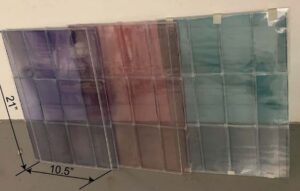Researchers in the United States have tested organic photovoltaic filters in a greenhouse hosting lettuce growth and have found the devices’ transmission spectra may help fine-tune the characteristics of the plant. They used transcriptomic analysis to assess the key modifications of the plants grown under the solar filters.

The three active OSC filters used in the greenhouse. Image: North Carolina State University (NCSU)
A group of scientists from the North Carolina State University (NCSU), in the United States, has tested three different filters based on semi-transparent organic solar cells (ST-OSCs) in a greenhouse intended for red oak leaf lettuce growth.
“There is wide spectral tunability with the organic semiconductors to tune the light that is absorbed by the solar cells and the light that gets transmitted to the plants,” NCSU researcher, Brendan O’Connor, told pv magazine. “Our work shows that this transmission spectrum can not only support healthy plant growth but may be used to promote gene expression in crops for desired characteristics.”
According to him, this spectral tunability, along with relatively high power conversion efficiency, is the key opportunity with organic solar cells. “Traditional opaque solar cell technologies block too much light,” he further explained.
In the paper “Beyond energy balance in agrivoltaic food production: Emergent crop traits from color selective solar cells,” published in bioRXiv, the research group explained that each filter was made with 12 organic PV units which each measured 20cm by 10cm, and which were arranged in a single layer on a substrate made of PEDOT:PSS coated onto a polyethylene terephthalate (PET) substrate.
The filters were placed on top of boxes designed to house the lettuce within a climate-controlled growth chamber. The boxes were positioned at the same height from the floor of the growth chamber so that similar amounts of light reached the plants in each treatment. “As expected, there were fewer differences between treatments when light intensity was controlled,” the scientists explained. “The spectral differences between the three OSC filters alone were not great enough to have a significant effect on biomass.”
The crop growth of the filter-covered boxes was compared to that of two reference boxes covered with a clear-glass or shaded control. “Our experiments were designed to account for both the quantitative and qualitative aspects of OSC-filtered light on lettuce as a representative crop,” the academics specified.
The researchers used transcriptomic analysis to assess the key modifications of the plants grown under the solar filters. Transcriptomics is the analysis that is able to provide the sum of all of the RNA transcripts of an organism. Comparing transcriptomes allows the identification of genes that are differentially expressed in distinct cell populations or in response to different treatments. “The advantage of a transcriptome analysis in the study of OSC-grown plants is that these key modifications can be identified without the need to directly measure each aspect of plant growth and development,” they emphasized.
Through this analysis tool, the academics found the physiology of the plants was altered by the differences in light quality under the OSC filters, on a molecular and transcriptomic level. According to them, the boxes are not only able to produce different crop species at an affordable cost but also to enable growers to fine-tune plant characteristics by selecting from the wide range of OSC transmission spectra.
In a previous study, the same research group analyzed the growth of red leaf lettuce (Lactuca sativa) in a greenhouse equipped with organic solar cells coated with filters that can manage both near-IR (NIR) and long-wavelength (LW) IR. Their analysis showed that the organic solar cells contribute to reducing overheating in the greenhouse and that lettuce growth proceeded unabated under the solar cells as the different transmission spectra had no impact on the fresh weight of the plants.
Author: Emiliano Bellini
pv-magazine


